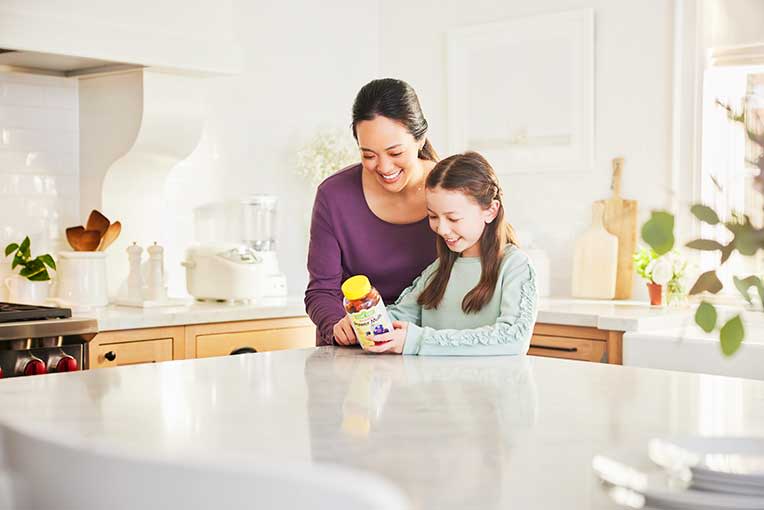Teaching Kids How to Read Nutrition Labels

Encouraging kids to eat healthy foods when they’re young is essential for their growth and development. But if you want these habits to stick, it’ll take more than encouragement.
Teaching kids to recognize the difference between nutritious foods and those that are unhealthy will help set the foundation for making healthy food choices throughout life. A vital part of this is showing them how to read the nutrition labels on foods.
How to Read Food Labels for Healthy Eating
It’s a lot easier to teach your kids about nutrition labels if you can understand the content of those labels yourself. A quick refresher with Health Canada’s resource on Understanding Food Labels will help ensure that your knowledge is up to date.
From here, you and your kids can enjoy working together to decode new food labels and make healthier choices.
Food Labels for Kids
Your kids may have already asked why some foods have nutrition labels and others do not. In Canada, foods such as fresh produce, raw meat, and bakery products, do not require a nutrition label. To learn about their nutritional content, you and your kids can use these resources:
For packaged foods with nutrition labels, kids should first look for its Nutrition Facts Table. Point out features such as serving size, grams of sugar, and types of fat.
In addition to the Nutrition Facts, kids should understand the importance of the ingredient list, how to check for allergens, and what the health and nutrient claims mean.
Nutrition Facts Table
The table on the back or side of a food package is a key place to start when you’re reading its label. It outlines four main nutritional points:
- Serving size
- Calories per serving
- % daily value
- Core nutrients
1. Serving Size
Show your kids how they can use the serving size to compare the nutrients between two similar foods. For example, compare the sodium content of different salad dressings or the amount of sugar in different brands of cereal. In most cases, the healthier choice will have the lower value per serving.
Although serving sizes are usually based on a reference amount for an adult, you can use them to teach your child about portioning food appropriately. Making healthy food choices means limiting your intake of foods that contain higher levels of:
- Sugar
- Sodium
- Saturated fat
The rest of the information on a Nutrition Facts Table is based on one serving.
2. Calories
The number of calories found in a serving of food is the amount of energy that it provides.
Sources of calories are:
- Carbohydrates
- Fats
- Proteins
Help your child understand how calories fit into their diet by comparing the calorie content of different foods. For example, blueberries and almonds are both nutritious, but with different amounts of calories due to their distinct ratios of carbohydrates, fats, and proteins.
Eating a wide variety of whole foods every day, including fruits and vegetables, whole grains, and lean proteins, will provide the calories that kids need to fuel a growing body and maintain healthy energy levels.
It is also important for kids to know that too few calories can cause low energy levels, hunger, and over time may cause weight loss.
3. % daily value
The % daily value (%DV) shows how much of each nutrient is in a food. Health Canada considers:
- 5% DV or less = a little
- 5–15% DV = moderate
- 15% DV or more = a lot
4. Core nutrients
There are 13 core nutrients shown on the Nutrition Facts Table. These are:
- Fat
- Saturated fat
- Trans fat
- Cholesterol
- Sodium
- Carbohydrate
- Fibre
- Sugars
- Protein
- Vitamin A
- Vitamin C
- Calcium
- Iron
This is a long list. To simplify it, focus on choosing foods low in:
- Sugar
- Sodium
- Saturated fat
Additionally, look for foods that contain 2 g or more of fibre.[1]
Ingredients
Just looking at the length of an ingredient list can tell you how processed a food is. Pointing out how many additives it contains will give your kids a sense of the nutritional value even before they read the details.
Showing kids that the ingredients are listed in order of weight is also helpful. A food contains more of the ingredients that are found at the beginning of its list.
Older children may also be interested in how many different names can be used for one ingredient. For example, there are over 20 forms of sugar that can be included on an ingredient list, such as high-fructose corn syrup, glucose, dextrose, and more.
Allergies and Intolerances
Approximately 7% of kids in Canada have a food allergy.[2] This is a big deal with school-aged kids and many classrooms restrict foods that contain allergens, such as peanuts and tree nuts.
It is important for kids to know how to check for allergens listed on food labels, whether they have allergies or not. A food’s ingredient list is the first place to check. Help reduce the risk of adverse reactions by pointing out common triggers on ingredient lists, such as:
- Peanuts
- Tree nuts
- Soy
- Wheat
- Egg
- Milk
- Fish
- Shellfish
- Sesame
- Sulphites
- Mustard
Some products may also have a precautionary “May Contain” statement that also identifies allergens.
Nutrient and Health Claims
Some food labels display extra information about a nutrient it contains or a health benefit that it provides. These claims can be fun tools for teaching kids the relationship between different nutrients and their related health benefits.
For example, use the following health claim to teach your kids the connection between calcium, vitamin D, and bone health: “A healthy diet with adequate calcium and vitamin D and regular physical activity helps achieve strong bones and may reduce the risk of osteoporosis”.
Likewise, identifying the nutrient claim “contains omega-3 fats” can easily lead to a discussion about healthy fats. Because there are so many versions of claims, you’ll be surprised how much you can learn from them.
Kids of all ages can grasp the idea that eating healthy food keeps their body energized and happy.
By teaching your kids to decode food labels early, you’re giving them an important tool for making healthy food choices as they get older. Before you know it, they’ll be shopping for and preparing their own healthy meals – and maybe even yours.
References :
- Agence canadienne d’inspection des aliments. Allégations relatives aux fibres alimentaires. Gouvernement du Canada. Consulté le 20 mars 2019. Données obtenues de : www.inspection.gc.ca/aliments/exigences-et-documents-d-orientation/etiquetage-normes-d-identite-et-classification/pour-l-industrie/teneur-nutritive/exigences-particulieres-concernant-les-allegations/fra/1389907770176/1389907817577?chap=12%7but1%7d
- Soller L, Ben-Shoshan M, Harrington DW, et al. Overall prevalence of self-reported food allergy in Canada. J Allergy Clin Immunol. 2012; 130(4):986-8.
 Free returns & exchanges
Free returns & exchanges



